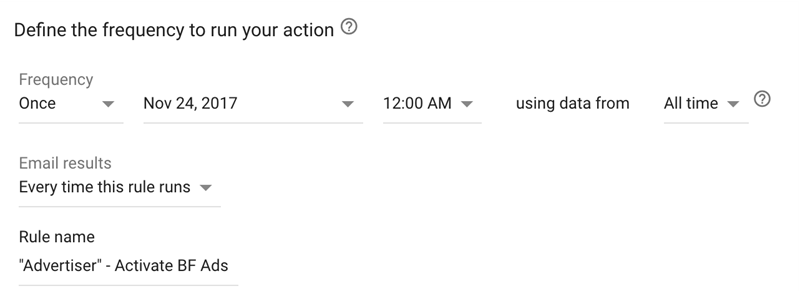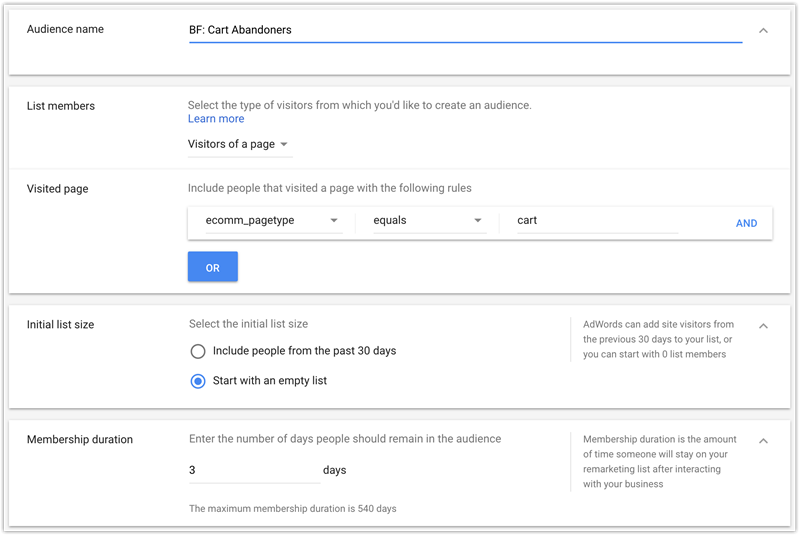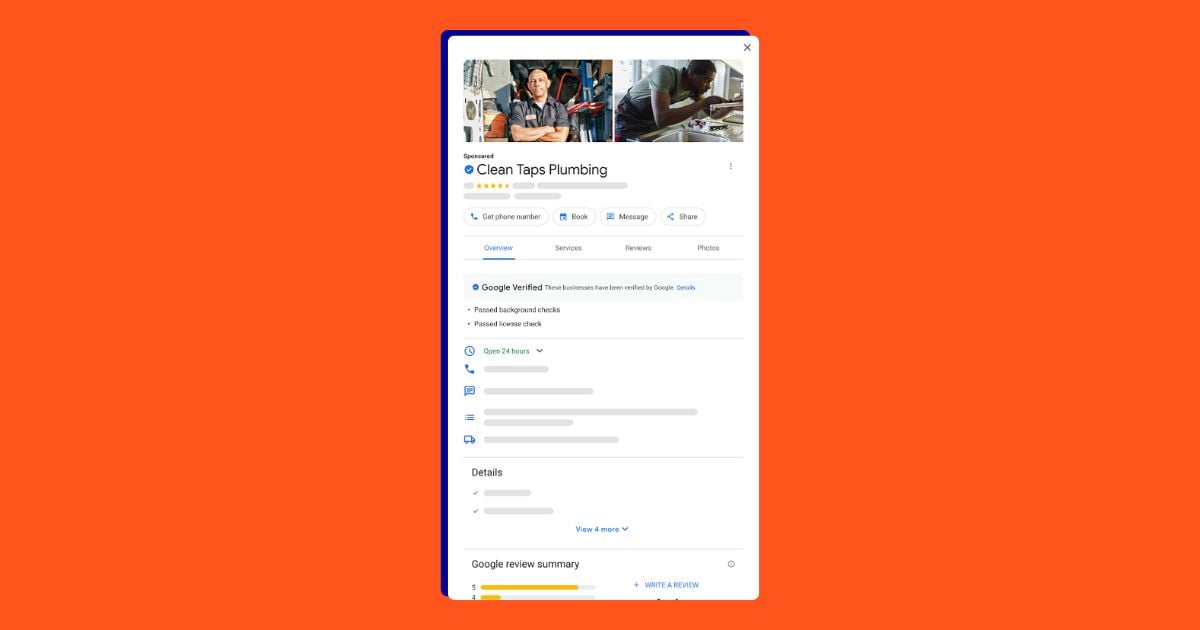Black Friday is a special day for PPC. Normally, we’re able to launch new campaigns and carefully mold them into perfection so we can reap the rewards for months, if not years to come.
Black Friday in Google Ads is different. You have a very short time to make the absolute most out of what you do. The wrong ad, bid, or settings can ruin your results.
No matter your strategy, the tips below will help you maximize your potential. We’ll be covering exactly what you need to do to adjust your bids and budgets, ad text and extensions, display and remarketing ads, keyword strategy, Shopping campaigns, and more.
Quick note: Whenever I refer to Black Friday, I’m actually talking about the entire Black Friday weekend. Some advertisers treat Black Friday differently from the rest of the weekend, while others see it as a five-day sale, starting on Thanksgiving and ending with Cyber Monday.
Table of contents
- How to prepare your Google Ads campaigns for Black Friday
- Budget and bidding tips for Black Friday PPC
- PPC ad writing tips for Black Friday
- How to maximize your Black Friday Google Shopping returns
- How to prepare your Google Shopping feed for Black Friday
- Black Friday display remarketing tips
- Black Friday Google Ads keyword strategies
- Black Friday Google Ads scenarios to be prepared for
- What to do after Black Friday
- Recap: what to do for Black Friday in Google Ads
How to prepare your Google Ads campaigns for Black Friday
In order to prepare for Black Friday, it’s essential to understand what promotions you’ll be running. It’s taking it back to ecommerce 101, but defining what promotions you’ll run will make a lot of sense as I go through the rest of the tips.
So first of all, find out:
- What will your offers be?
- Will you have enough stock?
If you don’t have a large stock, consider being less aggressive in your bidding or just pushing the product via Shopping or Search – whatever works best for you.
If you’re not sure you’ll have enough stock for a specific promotion, make sure you have a backup offer ready for your more generic keywords.
🎁 Get more holiday marketing tips here!
Review last year’s performance
I’ve written extensively about getting more success with PPC during seasonal swings, so I won’t dig too much into looking at historic performance.
The gist is that it’s crucial not to pretend this year is a single event. Despite the changing landscape in PPC, there are several areas that you can learn from based on historic performance. Some of these are:
- What did you learn from the ads you ran? Did any generic messaging perform better than others?
- Did ads that described the product benefits/features do better than the ads with price, shipping, and other specific info?

- What bid did it take you to get into the first position?
- Did any keywords or product categories turn out to be hard to advertise in?
- How did the sections of your account that didn’t have a promotion do?
- How big of an increase in spend did you experience? (Note, if you were capped out by your budget, then this is an important step for you to review)
- Was your Display Remarketing a bust or did it succeed on the day itself?
- What happened in the days after Black Friday and Cyber Monday? How much do you need to lower your bids in the immediate days after the promotion to avoid losing money?
And so on. Learn from what happened last year and you’ll be able to get more out of this year.
Define your rules of engagement
Before we get into the nitty-gritty I want to touch on one more non-PPC matter.
Chances are you’re not the boss. And even if you’re the boss, then this section will be healthy for you to prepare in advance.
Consider the following scenario: You’re expecting to spend $5,000 on Black Friday and aiming for an 800% ROAS.
However, Black Friday comes along and by 1 p.m. you’ve spent the entire $5,000 and have a ROAS of 1,100%. What do you do?
All the PPC managers yell: INCREASE THE BUDGET. But how much? What can the business afford? How much stock is left? And what if the ROAS was 700%? Should you still increase the budget? If you don’t have any stock left, do you have a backup promotion ready?
Having your rules of engagement set for the day can be incredibly powerful. You might think you’ll deal with that dream scenario if it happens, but what if on that same day your site starts loading slowly because of the high traffic AND your boss needs to pick up his sick daughter from school?
All of a sudden, you can’t get an answer until it’s too late.
Rules of engagement have the potential to save you a huge headache and give you a better opportunity to get the most out of the sale weekend.
Budget and bidding tips for Black Friday in Google Ads
Bidding is one of the trickiest areas to work with. Not necessarily on Black Friday itself, but afterward. If you run any type of automated bidding, you’ll have to run bids manually for at least 1-2 weeks after Black Friday due to the influx of data.
I haven’t personally found a bidding system where I can tell the system to ignore data generated in a specific time frame when it runs its algorithms. This poses an issue, as you’ll convert much better on Black Friday than in the weeks after. Depending on your industry, this might be a big issue.
To solve this, I typically do the following:
Download your bids the week before Black Friday
If you’re running automated bidding in Google, then remove the bids and look in Google Ads interface to see what the bids are. There are a few issues you should watch for, though.
Depending on the day and time you download your bids, you might get a different bid than the one that’s running the rest of the time. Especially with Google’s own ROAS and CPA bidding, automation changes dynamically based on day of the week and time of day (amongst other factors).
Therefore, there is a chance you might not get the actual bid you should reinstate after Black Friday, but it’s the best chance you have. It’s much better to reinstate a previous bid that might be 20-30% off than continue running the bids you had for the Black Friday weekend.
Increase your budget, significantly
It goes without saying that you have to increase your budget quite a bit on Black Friday.
For example, searches for smartphone deals go up 10X.
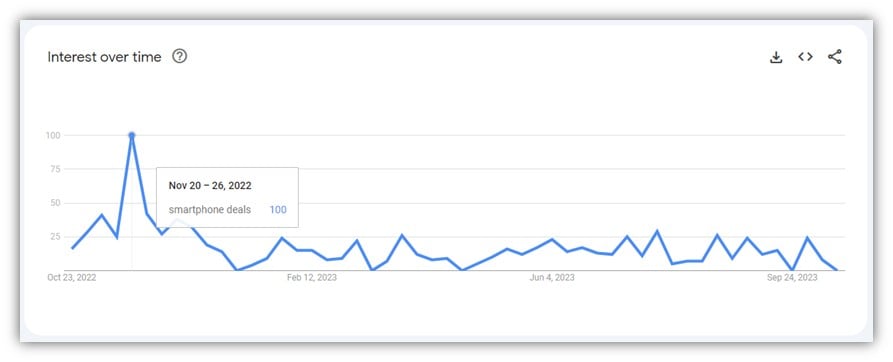
While searches for toys increased by 50%:

Ad writing tips for Black Friday
Writing ads for Black Friday is similar to writing ads for promotions throughout the year. Make sure they are relevant to the sale and use an adequate amount of ad space so users are aware of the promotion you’re running.
There are some specific factors you need to take into account for Black Friday, though.
I’ve split up the tactics in Mandatory and Recommended. If you’re new or this is your first Black Friday you can choose to just follow the mandatory tactics. But if you’ve been around the block, make sure you invest the extra time to do the additional Recommended tactics.
Mandatory for all:
- Set up a Promotion asset
- Add Black Friday references in your ads
Recommended for intermediates:
- Consider changing your sitelinks to specific products that will be in high demand.
- Consider adding Inventory References
How to set up Google Ads promotion assets
The promotion asset should be an essential part of your ad writing strategy moving forward. Your ads for Black Friday are no exception.
Promotion assets look like this:

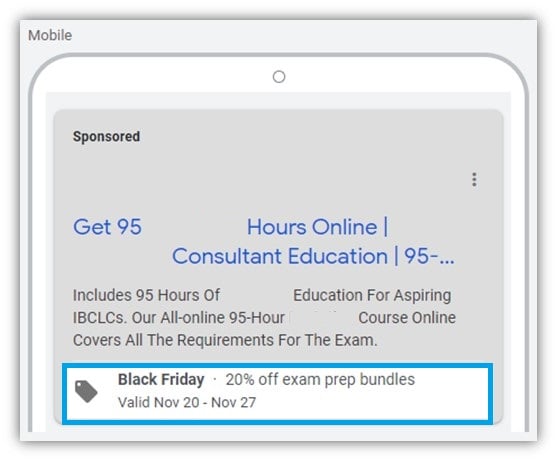
The extra line of ad text can really help set your ads apart from your competitors. The fact that it highlights a Black Friday sale is just the icing on the cake.
On top of this, you should also set your promotion to only run in a specific time frame. For Black Friday, this might be from Friday to Sunday.
This will give your ad additional space and add a sense of urgency to your offer.
Just remember, all ad assets aren’t necessarily guaranteed to show. It’s not enough to solely rely on the promotion asset to highlight your promotions.
Add Black Friday references in your ads
One of the oldest best practices is to make sure your ads are relevant, and one of the best ways to do that is to reference current events like Black Friday.
You can keep it simple, for example:
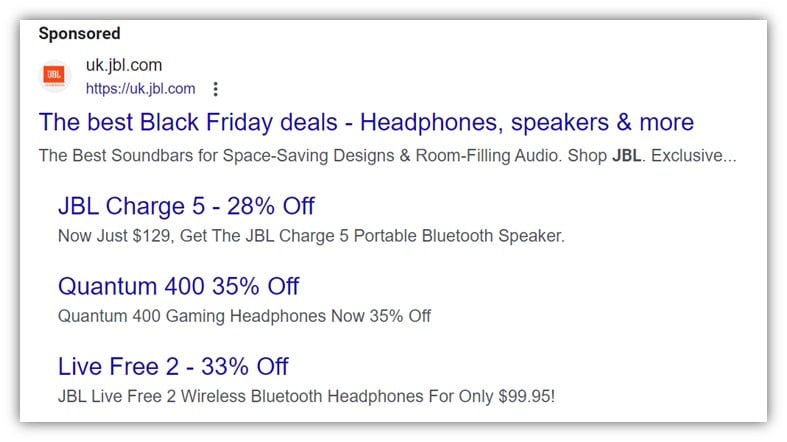
If you want the biggest impact for the least amount of effort, you can just change the second headline in all your ads to text referencing your Black Friday offer. This can be done super quick in the Google Ads interface.
For a higher CTR, better conversion rate, and ROI, I do recommend spending the time to write more specific ad copy for your most important products and categories.
Remember, Black Friday is a high-volume day. Any time you invest in writing better ads will pay off more than any other time of the year (with the exception of the Christmas season) – even if the ads only run for that day.
Change your sitelinks to specific, high-demand products [recommended]
Sitelinks are usually not the biggest focus area when writing ads. Most advertisers just take a minute or so to put in a couple of random sitelinks.
On Black Friday, it might be worthwhile to add a bit of extra finesse to your sitelinks. One idea is to include the specific products you run promotions for in your sitelinks.
So, let’s say you are running a campaign for Bluetooth speakers. Normally, you might have sitelinks like these:
- Most popular BT speakers
- Newest BT speakers
- BT speakers on sale
- All BT speakers
On Black Friday, consider adding sitelinks that are more specific to the offers you’re running:
- Soundlink: 33% Off Now
- 20% Off All Bose
- 25% Off Bose Headphones
- All Black Friday Sales
The reason why I advise going a bit broader than normal is because during Black Friday you are more likely to convince consumers to buy something they weren’t really out to get.
Many of us will just start searching for various products to see what deals are out there. Just because someone specifically searches for Bluetooth speakers it doesn’t mean they can’t be interested in headphones or other types of speakers if there is a good deal to be had.
Add inventory references [recommended]
Let’s say you create a killer promotion for Bose speakers. It’s right in the middle of being a sought-after product, at the right price with an exceptional promotion.
You start selling it and you can see that it’ll sell out by noon. Boom!
But you could have taken advantage of this in your ads. By indicating how many products are left, you can create even more scarcity.
Just make sure you have backup promotions for when you run out of a specific product.
Tag your current ads with the label “evergreen”
Running PPC for clients always makes you think of ways to do things more efficiently. Especially in eCommerce, as there are times of the year when the workload increases significantly.
Black Friday is that day.
Before you start your Black Friday ads, you should take all the ads in the ad groups where you will be adding the Black Friday promotion and add the label Evergreen.
That way you can easily pause the ads and reactivate them again when the sale is over.
The same way, you should label all your Black Friday ads with BF. You should probably add the year to your label as well. So for 2024, you’d add the tag BF-2024. That way you don’t accidentally activate last year’s ads next year.
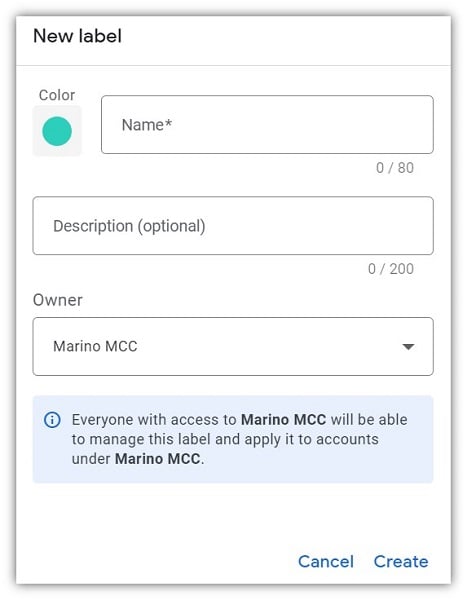
Write your ads at least a week in advance
You know those annoying emails you get from Google Ads about your paused ads being disapproved?
There’s a reason behind the madness, and it’s for days like Black Friday.
When you prepare your ads in advance (and upload to your Google Ads account) you’ll make sure that they get approved, or disapproved, well in advance of you actually needing them to run.
It’s a common mistake to write, or upload, your ads the same day that you need them. You’ll lose valuable time.
Use an automatic rule to pause and activate ads
The exact way you should build the rule is like this:
Just in case, I recommend checking the ads in your account and live in the search results. Even though I’m a big fan of automation, I’ve seen these things go wrong for the stupidest reasons.
While it’s not fun, you can normally live with ads not being live for half a day or even a couple of days, but on Black Friday you can’t afford to lose out on one hour of downtime.
How to maximize your Black Friday Google Shopping returns
Shopping campaigns are tricky when it comes to Black Friday. You have a lot less control than your regular Search campaigns, but Shopping campaigns still account for more than 50% of the revenue in most e-commerce Google Ads accounts, so you need to get this part right.
Create a new Shopping campaign
There are a couple of angles you can take with Google Shopping campaigns on Black Friday, but my go-to approach is the following:
- Create a new Shopping campaign for your most important products
- Use a “SPAG” structure (single product ad groups)
- Start it at least one week in advance, preferably two weeks
Depending on how many products you have, it can be super easy for individual products to slip through the cracks in your Shopping campaign.
By creating a new campaign, you’ll be able to keep an eye on the specific products you’re expecting will perform very well on Black Friday.
Just remember that if you’re using a tactic like segmenting your Shopping campaigns based on search query, then you should continue this with this campaign. You can quickly get in trouble with your ROI if you change that strategy for your key products all of a sudden.
Add storewide promotions to your new Shopping campaign
Okay. So you have a promotion that runs storewide with 20%. I get it.
It still doesn’t mean that all your products are equally important. If you look at your orders from the last 60 days, you must have a list of 10, 20, 50 products that vastly outsell the rest of your products.
Add these to the new Shopping campaign.
How to prepare your Shopping feed for Black Friday
This is where you need to make a decision. Do you run with a promotion that requires a coupon code (as listed above), or do you lower pricing in your feed and see it reflected in the ads?
Often, this decision will be made for you either by the strategy you take as a business (coupon or no coupon) or by the restraints of your platform.
If you run with the coupon code, then it’s crucial that you set up Promotions in the Merchant Center. Otherwise, your price in your Google Shopping ads will not reflect the actual lower price and it will undoubtedly decrease your CTR.
Lowered prices need to be reflected in your feed
It’s crucial that your feed contains the same price as on your website for each individual product. For two reasons:
- If your price isn’t lower in your feed, then your ads will show your original price, which will severely cripple your success on a day like Black Friday.
- There is a strong likelihood that Google will catch the price discrepancy and disapprove your product.
Again, from the time you catch this to the time the product gets approved by Google might take 4-6 hours. This is time that you can’t afford to lose. And that’s if you catch it at all!
I recommend regenerating/updating your feed and sending it to the Merchant Center right after you update the prices on your website. This might be midnight or it might be the day before. The second the prices on your website are updated, you should update your feed.
This is especially important as products go out of stock throughout the day.

Update your feed more frequently on Black Friday
Usually, you set your shopping feed to update every 24 hours. Typically at night.
On Black Friday I highly recommend you update it more frequently. Especially as products go out of stock or as you change your promotions.
Black Friday tips for remarketing
Most ecommerce stores run Dynamic Remarketing, but on Black Friday sending generic messages will not break through the digital noise.
I advise creating a new audience list solely for Black Friday. This means you’ll create a brand new audience the day before Black Friday that doesn’t include previous visitors:
This way you can set a more aggressive bid for the people who’ve visited your site on Black Friday and another bid for the people who visited your site before Black Friday.
Bonus tip: decrease remarketing bids after Black Friday
Lower your remarketing efforts in the days after Black Friday. Most users will have bought what they needed, or they simply weren’t interested in the first place.
Consider static image ads for your remarketing
I would highly recommend some sort of static images in your remarketing mix on Black Friday. Your regular dynamic display remarketing ads most likely look something like this:
Again, usually, this works great. But on Black Friday you’ll want something that pushes through the noise and delivers a message that adequately reflects the scarcity of the day.
Having some banners designed in the most popular sizes can be an easy win, and it shouldn’t cost you much if you use a site like Upwork to find a designer. If your store has an in-house designer, then spending some time on the designs in exchange for a pizza is well-worth the results you’ll most likely get.
The only thing I will add, which will complicate things, is to try to segment your retargeting when you do this. Meaning if a user visits the speaker section, then you’ll show a Black Friday display ad that contains your speaker promotion, etc.
You can try a general, generic banner, but it’ll be more effective if you put in the extra effort and create better-targeted ads.
Again, if your store is beyond a certain size this might prove impossible to do in practice. When you work at scale, you have to somehow limit your efficiency with hands-on tactics for the sake of getting out to as many people as possible.
Black Friday Google Ads keyword strategy tips
Your keywords should more or less stay the same for Black Friday.
I would highly recommend adding or reactivating keywords that have previously been paused for products you’re running promotions for. On Black Friday, most of your keyword portfolio will convert better than it will the rest of the year, which means you can afford to re-enable those keywords you paused due to low performance.
The exact opposite is also true. With keywords increasing three to four times in search volume, you want to consider pausing parts of your Google Ads account that you are not running promotions for.
Here’s an example of a search term that increased significantly when comparing to the same day a week before Black Friday:

With the added volume and the fact that your competitors will run promotions, which consumers are likely chasing, then your standard pricing will most likely not do anything to incite them to buy from you instead.
Advertise for “black friday + my keyword”
Yes, definitely.
You’ll already show up when someone searches for your keyword, so you might as well control the search by adding black friday to some of your keywords.
However, it will not make or break your success. In big markets, though, you want to be able to control it better. Let’s say that you’re selling Bose speakers, and you show up fine for searches on the keyword bose speakers, but you’re in position six for bose speakers black friday deal.
This search term might convert much higher than your regular keywords, so if your market is big enough it’s an excellent tactic to add black friday to your keywords.
Don’t advertise for the keyword “black friday“
It’s too broad for you to target effectively.
The exception is to create a campaign only targeting your remarketing lists that target the word Black Friday. Find your largest list. Say, anyone who’s visited your site in the last 6 months. Anyone who’s bought from you, well, ever. Add all of them to a remarketing list for search ads campaign with the Targeting targeting setting:
By doing this, you’ll show an ad to anyone who has ever visited your site and searches for Black Friday deals.
Since they’ve already visited your site once before, or possibly even bought from you, we can assume that they have some interest in the products you’re offering, despite them not showing any intent outright. (Remember–brand affinity dramatically increases CTR and conversion rates.)
Black Friday scenarios to be prepared for
Scenario #1: Low average position on key products
Make sure you review the early stats when it comes to your average position on Black Friday. If you’re coming in low for some of your key products, consider increasing your bids.
Throughout the day you can decrease or increase as you normally would based on ROAS, but you need to make sure your keywords have a fighting chance in a proper position.
Your position should preferably be in the 2-3 average position range. This will depend a lot on your ROAS, but the higher position your get, the more ad extensions and CTR you’ll get–which all results in more sales.
Scenario #2: No sales of key products
You need to be ruthless about admitting to yourself if you’ve been beat. It might not even be related to your Google Ads efforts.
Does your competitor run a better offer than you?
If so, then you might want to mimic their promotion or cut your losses. It’s incredibly difficult to beat a competitor that’s severely beating you on price under normal conditions.
On Black Friday with zombie-like consumers chasing deals like that kid on the Walking Dead, it’s almost impossible.
If you’re not getting anything out of your Black Friday efforts in some of your campaigns, consider solely focusing on remarketing. That way you’ll only show your ads to people who’ve visited your site before. With this strategy, you’ll bank on the fact that these consumers know who you are, which has been proven to impact your conversions significantly.
Scenario #3: Budget maxed out
You should routinely check in on your budget. Make sure that you’re not maxed out, or about to max out. If you are maxed out, consider adding more budget based on your rules of engagement that you’ve established.
What to do after Black Friday?
Make sure you do the following in your PPC account once the Black Friday madness is over:
- Reinstate your old bids
- Pause Black Friday ads
- Re-enable your evergreen ads
- Do an after-action report
- Have a beer and enjoy sending out all those orders!
When you review your performance in the days after Black Friday, make sure you don’t take these days into account. For many advertisers, the days after Black Friday can be a time to lose a lot of money.
Wow, Black Friday in Google Ads is… a lot…
If this was more than you could handle, I don’t blame you. It was a bit of a brain dump.
I created a checklist version of this article that you can print out or save for later. Get your simplified Black Friday checklist here.
I’ve also summarized the most actionable Black Friday PPC tips below:
For Bids
- Download your bids a week in advance, so you can reinstate them after Black Friday
- Increase your budget, significantly
For Ads:
- Set up the promotion extension
- Add Black Friday references to your ads
- Consider changing sitelinks
- Consider adding inventory references
For Shopping
- Add a new campaign with your most important products (or the products you run promotions for)
- Use Merchant Center promotions, OR include sale_price in your feed
- Upload your updated prices in your feed around midnight
Remarketing
- Focus your bids around your most recent visitors
- Decrease your bids significantly in the days after Black Friday, or exclude Black Friday
Keywords
- Add previously paused keywords that cover products that are on sale
- Increase bids for low-position keywords that cover products that are on sale
Whatever you do, it’s crucial that you set yourself up for success on Black Friday. Take the time and acknowledge that you can’t just be in maintenance mode.
Get out of your comfort zone and start making some changes in your account.
Want more Black Friday tips? Find out how to drive results from your Black Friday Facebook ads!

